TRD
Supercharger Kit


Contents:

Introduction:
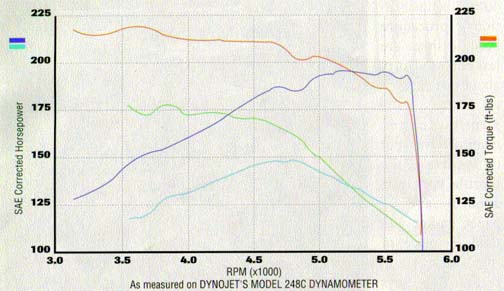
This dyno chart was
scanned out of Today's SUV Magazine. It shows the before
and
after supercharger dyno runs. This chart shows an increase of
40 peak HP and a
max increase of near 60 HP.
There is
no other performance modification that comes close to
the fun that the TRD Supercharger can give you. Most
other mods might give you some added performance in
one area while decreasing it in another. The
supercharger increases performance in all areas, low,
midrange, and top end.
Most people and I report
loosing only 1 MPG after installing the supercharger.
That is a wonderful trade off for the added fun you
will get from installing it, not to mention the cool factor.
Back
to page index

How
a supercharger works and different types:
The engine draws into the
cylinders when the pistons are moving downward in the
cylinders. This creates a pressure in the cylinders that is
less then the air outside the engine. The air outside the
engine tries real hard to move into the area of negative pressure in
the cylinder. What this means is that air is not sucked into
an engine but forced in by the higher air pressure outside the
engine.
The amount of air the engine
can consume, mix with fuel, and burn determines the how much power
the engine can make. Usually, engines of greater displacement
can consume more air and fuel and make more power.
The down side to this is
that engines of greater displacement have larger internal friction
surfaces inside and that robs power. In cruise a car requires very
little power to maintain speed on level ground. Lets say a car
needs 18 HP to maintain 60 MPH. Now if you use a very small
engine to make that 18 HP it will be more efficient due to less
internal friction then a very large engine making 18 HP. This
is the biggest reason that smaller engines get better MPG then larger
engines in cruise. The problem is there are times that you
need much more power like merging into traffic on the interstate.
This is where a bigger engine comes in handy, but you pay a fuel
penalty when that larger engine is not needed.
There are advantages to
making a smaller engine more powerful. That way they can make
the power needed, and still get better fuel economy. One way
to do this that is getting more popular is to force more air into
the engine then it would normally draw in on its own. This can
be done with some kind of forced induction. The most common
ways to do this is with a turbocharger or supercharger.
A turbocharger has a turbine
that is driven by spent exhaust gasses and that in turn spins a
compressor wheel. The compressor wheel causes more air to
enter the engine then it would normally draw in on its own thereby
increasing power. The advantage to an exhaust driven turbo is
that it is more efficient then an engine driven compressor AKA
supercharger. A piston engine is said at best to be only 33% efficient.
1/3 of the energy released from the burning gas is converted to heat
that goes into the engine's cooling system. 1/3 of the energy
powers the car. 1/3 of the energy goes out the exhaust pipe as
heat. The turbocharger harnesses some of that 1/3 wasted
energy that goes out the exhaust to increase the power of the
engine.
There are lots of other
things that are really nice about turbochargers, but in an
aftermarket bolt on application they can be very complex to install
as it involves lots of plumbing changes in the exhaust, air
induction system, oil system, and so on. This is where the
supercharger has some advantages. It is an air pump that is
driven by a belt from the crankshaft and no mods to the exhaust
system are needed. Overall the biggest advantage is it utter
simplicity even if they are less efficient then a turbocharger.
Another advantage is the impellers are always turning at the ideal
speed to provide full boost as soon as the throttle is opened.
In a turbo you have to wait for the turbo to speed or spool up to
provide the boost. That is called turbo lag. That does
not happen with the engine driven supercharger, you get boost as
soon as you crack the throttle.
Centrifugal
and Positive Displacement Superchargers
There are two basic types of
superchargers, positive displacement and centrifugal.

The centrifugal
superchargers use the same type of compressor impeller as a
turbocharger and the faster they spin the more boost they make and
it is not linier. If you double the speed of the compressor
you quadruple the output. The problem is that they only make peak boost at the
engine's redline and tend to make very little boost at lower engine
speeds where they are mostly operated. These are the type used
by the well known Paxton and Vortech
brand. In automotive use they really
are not the best choice because of the very wide RPM ranges used in
normal operation. They are very well suited for aircraft use
where the engines are operated in a very narrow RPM range the entire
time the aircraft is in flight. There are many auto
manufactures that are using positive displacement superchargers on their
cars, Mercedes, Jaguar, Ford, GM, Saab and many more. Not a
single one that I know of is using a centrifugal supercharger.
There must be a real good reason for that.
The positive displacement
supercharger will move a fixed amount of air on each rotation and
that is not dependant on impeller speed as it is on the centrifugal
type. When a positive displacement supercharger's size is
properly matched to an engine and it turned at fixed ratio to engine
speed it will produce a set amount of boost throughout almost the
entire RPM band, from just off idle to full RPM. There are
great advantages to this over the centrifugal type superchargers and
that is why they are the better choice.
Types
of positive displacement superchargers-
Reciprocating-

This is the common piston in
cylinder type. These are mostly used as air compressors and
not to many are used as superchargers as they are not any more efficient
as the piston engine its self.
Vane-
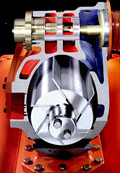 
These use a central shaft
with sliding vanes inside a housing of decreasing radius. They
have been used on older cars of the past. The most current use
of this type that I know of was the VW G-Lader. This also very
similar to most power steering pumps.
Wankel-
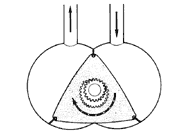
That's right the Wankle
engine started out as a supercharger before someone got the idea to
install spark plugs and shooting in gas and call it an engine.
Lysholm-

Lysholm superchargers are similar
to the modified roots type, but the impellers are dissimilar.
One is a male rotor of three or four lobes and the other is a female rotor
of five lobes. The Lyshlom superchargers are used more in
applications where the boost pressure is over 13 PSI.
The reason for this is that the supercharger compresses the air to a
high degree inside the supercharger and it decompresses as it enters
the plenum. The advantage to this is that the air in the
plenum will not back flow into the supercharger as the pressure in
the supercharger is always more then in the plenum. The side
affect to this is higher heat and more parasitic drag then the
modified roots type in non and low boost conditions.
Saab and Mercedes Benz uses
the Lysholm superchargers, but Mercedes only uses them only in their
high boost applications and the Eaton modified roots type in their
low boost applications. Currently Mercedes is using Japanese
made Lysholm superchargers and has asked Eaton to supply them for
their high boost applications. Eaton has obtained the license
from the patent holders to start producing Lysholm superchargers for
Mercedes.
There are some aftermarket
companies that use the Lysholm supercharger in their kits.
Some of them are Stillen and Kenne Bell. They are sometimes
referred to as screw chargers.
Roots and Modified Roots
Type-
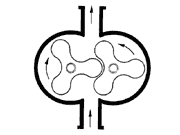
The roots is the oldest type of positive
displacement supercharger. They started out life made of wood
and were used to ventilate mines and as blowers in blast furnaces.
This is the type you see sitting on top of those big top fuel
dragsters. In these the air comes in one side and travels
around toward the outside of the housing and as the impellers mesh
the air is forced out the other side. The most common use of
this type supercharger or blower is on the Detroit two stroke diesel
engines. They are needed to force air into the intake ports on
the two stroke diesel engines and they would not run without
them. This is the type of engine that is used in most of the
fire trucks and buses. It is not known as the most efficient
type of supercharger. The later Detroit two stroke engines had
both a blower to make them run and a turbo for top end power. This
was done in the Silver series until the Feds banned them for
emission reasons. You now will only find new ones in marine
applications.

This
is what the impellers look like inside the TRD Supercharger. Notice
the twist of the impellers.
That is modification that Eaton came up with to make them more efficient.

This
is a picture from the intake end of the impellers.
To make the Roots type
more efficient, Eaton has modified the impellers by adding a twist
to them and moving the intake port to the end. This makes them
more efficient and quieter. This is called a "Modified
Roots" type supercharger. This is the type used in the
TRD Supercharger kit. The biggest difference between the
modified roots type and the Lysholm supercharger is that the
modified roots type has two impellers that are same, where the
Lysholm uses two dissimilar ones, a male and a female rotor.

This
is the supercharger housing. The intake port is the big hole on the
bottom in the rear.
Air is draw in there to fill the empty space between the impellers
and then carried out toward the outside
and toward the top. When the impeller lobes intermesh at the
top the air is forced out of the space
between the lobes and out the discharge port on the top. You
can see the little holes on each side of the
discharge port. Those are placed there to increase the
discharge efficiency and is called "S" porting. That
is
fairly new thing.
The modified roots type is
the best type of supercharger to use until the boost pressure
exceeds 13 PSI. At that point the pressure in the manifold
starts to exceed the pressure in the supercharger housing and it
starts to backflow into the supercharger and decreases its output
and the heat generated really goes up. Above 13 PSI the better
supercharger would be the Lysholm type. It is said that the
compression of the air occurs in the plenum after it leaves the
supercharger in the modified roots type supercharger unlike the
Lysholm where the air is compressed inside the blower and then
decompresses as it leaves the blower and enters the plenum.
The advantage with the modified roots type is that it has less
parasitic drag on the engine when boost is not needed. The
Eaton superchargers also use a bypass valve that equalizes the
pressure on both sides of the impellers when the engine is operating
in vacuum. This takes more load off the engine and reduces the
heat generated in non-boost conditions. The Lysholm is still
compressing air internally even during non-boost conditions and this
generates heat and has more parasitic drag on the engine during
non-boost even with a bypass valve. Mercedes Benz does use some
Lysholm superchargers
on their super cars and they employ a clutch to disengage the
supercharger from the crank shaft during non-boost conditions to
counter the negatives of the Lysholm superchargers.
Overall the modified roots
type supercharger is the much better choice if you are staying under
13 PSI of boost. This is why most of the OEM producers choose
the Eaton modified roots type superchargers for their production
cars.
The Eaton modified roots
type supercharger is the one that is best suited for the Toyota 3.4
supercharger kit given its low boost, low parasitic loss during
non-boost conditions, and instant full boost throughout most of the
RPM band.
Back
to page index

The TRD Supercharger kit:


The kit is produced by
Magnuson Products for TRD. They also make kits for other
companies like Jackson Racing and
Neuspeed, and help develop supercharger
applications for many of the OE manufacturers, like GM. The original supercharger kit which
is the one that I have uses an Eaton M-62 3rd Generation
supercharger. It has a 62 cubic inch displacement. The
first design kits had a separate plenum that the supercharger was
bolted to. The plenum is the part that carries air to the
engine that is higher then atmospheric pressure also know as boost
pressure. It also doubles as the mounting for the
supercharger.

The newer or current
supercharger kit uses a single casting for the supercharger housing
and plenum. It is based on the newer 4th generation Eaton
supercharger. It differs from the 3rd generation mostly in
respect to the bypass valve. In the 4th generation the
supercharger body has the bypass valve cast into the supercharger
body where on the 3rd generation it was a separate part that had to
be plumbed into the works some how. This saves space and
allows a more compact installation so it can be fitted to more
applications. Magnuson has taken this to the extreme and made
the supercharger body, bypass valve, and plenum all one casting to
make for a very compact installation. Some people get confused
thinking that the new supercharger is a totally different
supercharger. It really is not. It is still an Eaton
M-62, 62 cubic inch supercharger. Magnuson has really done a
fantastic job on the second version. The layout and casting is
very well thought out and still uses all the factory connections and
cables. The newer one is easier to install saving on
installation time and confusion.
You can download a
compressed file containing several pictures of the 2nd Generation
TRD Supercharger Kit by clicking here.
You can see how Magnuson cast the housing, plenum, and bypass valve
all as one compact unit. It is very nicely done.
Back
to page index

Installation:
The supercharger replaces
the upper and lower intake connectors and bolts to the
manifold. The upper intake connectors are the long aluminum
tube looking things that are between the throttle body and the
intake manifold. The kit retains the stock throttle body and
all the vacuum hose connections. If you have an EGR system on
your truck there is a provision for this, but you will have to
purchase an EGR adaptor kit at extra cost.
The installation is fairly
simple and requires unbolting and removing the intake connectors,
installing a longer alternator belt that will now also power the supercharger and
reconnecting all the vacuum hoses. The hardest part of all is
removing the A/C compressor and power steering belt to get to the
alternator belt. This is not hard to do, but is
tedious. If you can replace your
belts then you can install your own supercharger, it is that easy, really.
You can go the the TRD
website and download the installation instructions and read them
over to see what you are getting yourself into. I suggest if
you can, install the supercharger yourself. That way you will
be more familiar with the supercharger, hose connections and other
parts of the engine that can help you trouble shoot problems in the
future. From the countless emails I get, I would have to say
that most of the problems come out of installation errors from
dealer installations. There is also a good chance that the guy
at the dealer that is installing your supercharger is installing his
first one. If you do go that route try to find a dealer and a
mechanic at the dealer that has installed a few before yours and can
demonstrate to you that he knows what he is doing.
The most common installation
errors are miss routing vacuum lines, specifically the power
steering idle up line and the 4x4 vacuum supply line so pay specific
attention to those. The next most common error is not properly
installing the throttle body gasket. Putting it in backwards
will cause a check engine light in a short period of time showing a
lean code. Make sure you use the gasket that comes in the kit
and make sure it is in the right way. Lastly, it seems that
many dealers forget to install the check valve in the air assist
line. This prevents boost pressure from back flowing through
the air passages in the fuel injector tip and back out toward the
throttle body. This can take needed fuel with it preventing it
from being injected into the engine under boost. Make real
sure that the check valve is installed in the air assist line and in
the proper direction.
Back
to page index

Warranty:
Many people seem to get
confused about the warranty. Here is my impression of the
warranty, it is simple really. If you install the supercharger
it will be covered by a 12 month unlimited mileage warranty.
If you decide to pay the dealer to install it, the supercharger is
rolled into the remainder of the drive-train warranty. If it
is installed on a new truck by the dealer it will be covered for 5
years or 60,000 miles. I know that sounds good, but most of
the problems with installation seem to be from dealer installations,
go figure.
My truck had 44,000 miles on
it when I bought my supercharger and was putting about 30,000 miles
on it at the time. It seemed that if I paid the dealer to
install it I would be out of warranty in about six months. Of
course I installed it myself in less then four hours with a lunch
break.
The warranty on the truck
itself is not affected at all no matter who installs the
supercharger so do not worry about that.
Back
to page index

Where is the boost port?:
This seems to stump a great
many people including the pros at the dealer. The boost port
is the connection for things you may want to install with the
supercharger that need to have access to positive boost pressure
from the supercharger. These things may include a boost gauge
and other gadgets that need a boost pressure signal.
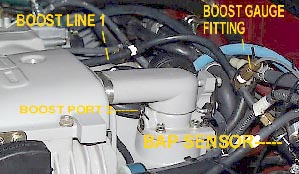
In the picture
above, the hose labeled as boost line 1 is connected to the boost
port on this 1st Generation TRD Supercharger. This is the
fitting that you want to connect thing like the boost gauge to so
that they will have access to boost pressure. The port labeled
as Boost Port 2 is also a port that will provide access to boost
pressure, but it is normally connected to the bypass valve actuator
and should be left alone.

This is a
picture of the rear side of the 2nd Generation TRD
Supercharger. This side normally faces the firewall. As
you can see the boost port comes plugged and is the ONLY port on the
supercharger that you can get a boost signal from. You will
have to remove this plug and screw in a nipple that you can attach a
vacuum line to. Many people opt to have the TRD boost gauge
installed when they supercharger is installed by the dealer and it
seems that many of them only read vacuum on the gauge. The
reason for this is that it is not connected to the boost port.
The gauge will not read properly if it is not connected to this
port. The port on the right labeled as vacuum port is the best
place to connect the 4x4 vacuum supply line to, another typical
error in the installation of the supercharger.
Back
to page index

Problems with the
supercharger its self:
Overall the superchargers
have proven to be very reliable and problems with the supercharger
itself have been very few. There have been some installation
errors, but that is expected to some degree.
I have heard of a few diaphragms
blowing out in the bypass valve actuators. On the later
version the vacuum line is connected to a vacuum source only to help
reduce this problem. I have installed a couple 2nd generation
superchargers and found that the bypass valve travel stop set screws were
not properly set by TRD and that caused the valves to over travel
and stick. You may want to check the adjustment on yours.
There have been some
superchargers with bad input shaft seals. This allowed the oil
in the nose drive to leak out around the pulley. The ones
under warranty had the entire supercharger replaced by TRD. If
this happens to you out of warranty you can just replace the nose
drive. You can get an exchange unit from Magnuson. This
problem seemed to affect a small batch of superchargers and other
then that has not been a big problem on units outside this one
batch.
If you are having oil
leaking out of your nose drive do not let TRD tell you it is normal
or it is just the break in lube. That seems to be their standard response,
the fact is it is NOT normal and needs to be address right
away. There are only four ounces of oil in the nose drive and
it can run dry very fast.
The supercharger does make
noise, it is supposed to. Under boost it will make a wonderful
whine sound that most find very pleasant. At idle it will make
a rattling like sound. That is from gear slack in the nose
drive. The supercharger uses straight cut gears in the nose
drive and at idle there is no load on the gears that they tend to
rattle back and forth a bit and that presents as a rattling
sound. It should go away if the engine is rev-ed up just above
idle. This is all very normal. As the supercharger ages
the rattle sound at idle may get louder. I replaced my nose
drive at 65,000 miles and the rattling sound was greatly reduced.
You can jump over to my supercharger
maintenance page for information on how to keep your
supercharger in top condition.
Back
to page index

Short
comings with the TRD Supercharger kit:
Although the Magnuson did a
fantastic job developing the supercharger for TRD, I feel there are
some short comings in the kit. The hardware part is beautifully
done, but there are some issues that have not been properly address
in my opinion. They are:
You can click on the links
above to find out why I think they are problems and what I have done
to fix the problems. Many of the other aftermarket
supercharger kits are complete kits and include different ways to
address issues with the ignition system, fuel system, and some even
include transmission upgrades to prevent damage from the added
power. Some of the folks that make a complete kit are Kenne
Bell, Stillen, Safari from Australia, and Alpine from South
Africa. TRD simply tells you that additional upgrades
are not needed. I disagree with that, but I guess because you
can bolt on the supercharger and it will run without any other
upgrades then I guess they are not lying, but I can tell you things
can be so much better with a few other add-ons.
Alpine from South Africa
makes a real nice supercharger kit for the Toyota 2.4 and 2.7 truck
engines. The kit comes complete with extra fuel injectors and
a piggy back engine computer to retune the engine for the
supercharger. TRD recently struck a deal with Alpine to
produce a stripped down kit for TRD to market as their own
kit. It uses a smaller supercharger and does not have the
extra injectors or piggy back computer and costs a lot more, but
does have the pretty TRD label on it. I think you would be
better served by getting the original Alpine supercharger kit that
is available in sever versions and boost levels. Because of
the import agreement between TRD and Alpine, TRD now has the
exclusive import rights to the 2.4 and 2.7 supercharger kits in the
US. There is a small loop hole that you may want to take
advantage of. It was several members or Tacoma Territory that
initiated the importation of the supercharger kit to the US that
later led to TRD marketing it. If you are a member of Tacoma
Territory you can still import the original complete kit direct from
Alpine. Look up the New England chapter site of Tacoma
Territory for more info on the 2.4 and 2.7 supercharger kit if you
want.
There is a good reason why
TRD does not include fuel and ignition upgrades with their
supercharger kit. I was told by the folks at TRD the reason
they do not do so is that they are being restricted by Toyota.
TRD is part of Toyota in North America and because they are an arm
of the manufacturer they would have to submit the entire kit with
upgrades for EPA approval just like it was a new complete car.
There simply is not enough profit in the supercharger kits to cover
the cost of getting something like this through the EPA approval
process, so can not include ignition and fuel system upgrades and
the engine will run without them, but I can tell you for certain, it
will run so much better with some additional tweaking in the fuel
and ignition system. That is my understanding of what I was
told by the folks at TRD.
When I was told that story
by a guy at TRD, I recommended a way for them to get around all of
those restrictions. My idea was to start another company
separate from TRD and Toyota, or have another company provide the
fuel and ignition upgrades for them. Then market the
superchargers at a much lower boost level where the stock engine
control system can handle things just fine and call that a stage I
kit with full warranty even if it needs to be 2-3 PSI. Then
tell people that want more that they can get the stage II kit from
the other partner company complete with a higher boost pulley and
fuel system enhancements with a disclaimer that they can not
warranty the upgraded kit. That will give every one what they
really want. Shortly after that conversation the Kazuma off
shoot of TRD was announced. When the Camry supercharger was
announced on the TRD web site they said that it came with a low
boost pulley, but would sell you a smaller higher boost pulley that
would need fuel system mods. They would not sell it, but could
refer you to a company that will sell you fuel system upgrades.
Interesting, don't you think?
Back
to page index

|